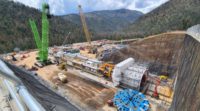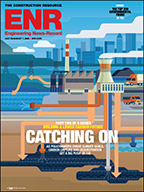To cover graffiti, municipal officials in Australia have been slapping beige paint on many public spaces. That trend spurred the graffiti artists to “take their own action against the beige whitewash,” restoring the colorful urban art, as one website demanded. Brisbane-based engineering firm Cardno Ltd. is also in the process of adding color to its beige persona, expanding its traditional geographical reach and offerings and raising its low profile to become a bolder, world-class contender. Wrapping itself in red, white and blue, the firm is making a targeted foray into the U.S. market as a base for ambitious global growth and market diversification.
The strategy appears to be working. The 56-year-old engineer that struggled to keep its 200-person staff during Australia's mid-1990s recession has become a well-capitalized public giant with 4,200 employees in 160 offices in 72 countries. About 60% of the employees are based outside Australia.
Revenue for Cardno's 2011 fiscal year ending on June 30 won't be revealed until mid-August, but analysts predict it will exceed $875 million, up from $506.4 million a year earlier. Furthermore, the company already has announced it expects a record profit— between $60.5 million and $62.8 million—for its last six-month reporting period, up at least 51% over the same period of last year.
Cardno debuts at No. 35 on ENR's Top 200 International Design Firms list (see p. 35) with $325 million in calendar-year 2010 revenue outside its home country. It ranks at No. 60 on ENR's Top 150 Global Design Firms list, with $617 million in total reported 2010 calendar-year revenue.
The firm touts market savvy in traditional infrastructure work, from highways to water treatment plants and mine-site expansion, and it has been part of high-profile environmental disaster response, such as after last year's oil-platform explosion in the Gulf of Mexico. The firm also is building a new market niche in the delivery of “social” infrastructure to developing nations, from running elections in Papua New Guinea to delivering education in Indonesia to creating health registries in Armenia.
“I think Cardno is a pretty remarkable success story so far, especially since it was a relatively small Australian firm just five years ago,” says Andrej Avelini, managing director of industry financial consultant EFCG, New York City, which has brokered several of the firm's key U.S. acquisitions. “They are young, dynamic and direct, yet also thoughtful and somewhat soft-spoken in their approach, and that has resonated well.”
The master craftsman behind Cardno's push to build a distinctive franchise is its CEO and managing director, Andrew D. Buckley, a mechanical engineer whose low-key demeanor belies his desire to get the firm noticed. “We're under the radar, but we're starting to stick our head up in global markets,” he says. “We have the vision to be a world leader.”
The employees applaud that vision. “Our company did good work, but there was nothing to differentiate it from other firms,” says Michael Renshaw, an Australian who is now Cardno's Americas general manager and a rising star in his own right. “Andrew brought a culture of growth, client service and performance. He has enabled us to transform the company into a vibrant, entrepreneurial and exciting place to work.”
As evidenced by Cardno's stable of some 35 acquisitions since the 1990s, the vision is compelling to outsiders as well. New U.S.-based holdings have propelled the firm up the ranks of ENR's Top 500 Design Firms. Cardno USA debuted on the 2010 list at No. 137; this year, it ranks at No. 34, with $356 million in revenue reported. “We've attracted 2,000 people to work with us in the U.S.,” says Renshaw. “Only two have left.”
Australian stock analysts tout as a good value shares of the firm, which went public in 2004 to finance its global push. “We retain the view that [Cardno] looks to be in a cyclical sweet spot, leveraged to strengthening activity in Australia and a U.S. economic recovery,” says Roger Leaning, senior analyst at RBS Morgans, Sydney. “Consequently, we see further upside over the next 12 months.” Analyst Toby Bucks at CLSA, also based there, cites an acquisition “war chest” of more than $212 million “to drive organic growth through cross-selling.”











Post a comment to this article
Report Abusive Comment